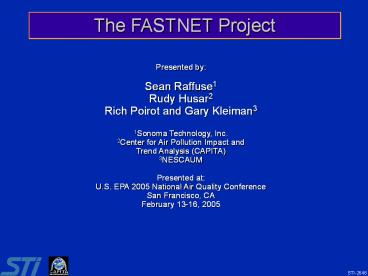The FASTNET Project PowerPoint PPT Presentation
1 / 23
Title: The FASTNET Project
1
The FASTNET Project
Presented by Sean Raffuse1 Rudy Husar2 Rich
Poirot and Gary Kleiman3 1Sonoma Technology,
Inc. 2Center for Air Pollution Impact and Trend
Analysis (CAPITA) 3NESCAUM Presented at U.S.
EPA 2005 National Air Quality Conference San
Francisco, CA February 13-16, 2005
STI-2646
2
FASTNET
- Fast Aerosol Sensing Tools for Natural Event
Tracking - Brings together real-time and historical data
sets useful for aerosol analysis into several web
based consoles - Developed by the Center for Air Pollution Impact
and Trend Analysis (CAPITA) and Sonoma
Technology, Inc. (STI) - A Regional Planning Organization (RPO) project
- Managed for MANE-VU by Northeast States for
Coordinated Air Use Management (NESCAUM) - Currently functional and freely accessible
3
On Aerosol Events and Data
- Aerosol episodes are often complex
- Different components, shapes, sizes, mixing
- Natural and anthropogenic sources
- Transport and carryover
- Aerosol data sets come from a variety of sources
and are difficult to use - Data sets are large, many different formats and
cumbersome - Stored and maintained at various locations
- Dynamic
- Represent different time/space scales
- Aerosol data need to be integrated and presented
in real time - Individual data sets can only provide narrow
views of aerosol events - Data integration provides a broader
characterization of events - Synthesizing datasets helps better understanding
aerosol events
4
FASTNET uses the DataFed.net infrastructure Suppor
ted by NSF, NASA, EPA and other Agencies
FASTNET is one of many projects within
DataFed.net which share common data sets which
are archived and accessible and can be viewed,
compared, exported, analyzed, and interpreted
using a variety of web-based applications
5
DataFed Synthesizes Data for Analyses
Data Retrieval Service
Websites
Data
Outputs
Maps
Analyst Consoles
Graphs
Image Files
Connects to various data types
XML
Ambient Monitors Emission Inventories Fire
Locations Meteorology GIS Maps Satellite Imagery
Custom Consoles
CSV
And creates standard data views
Which can be incorporated into websites
Manager Console
6
AIRNow and FASTNET
The AIRNow PM2.5 data set is the benchmark
parameter used in FASTNET The products of
FASTNET have the potential to be returned to
AIRNow to provide context
Event analysis, packaging, and context
Tools and the analyst community
Hourly PM2.5data
7
Real-time
Real-time
Real-time
8
Data catalog(s) provide access to many fast
(rapidly available), current (near-real-time,
recently archived and continuing), and slow
(historical data like IMPROVE Aerosol and ATAD
trajectories)
9
Event Analysis February 19, 2004
- Areas of elevated PM2.5 in the Great Lakes (MN,
MI), Northeast, and West Texas - What are the features?
10
This is one of several Analyst Consoles
Visibility
Meteorological parameters
Satellite indices
Aerosol models
Fires
Imagery
11
February 19, 2004 Texas Dust Midwest Nitrate
- Isolated high PM2.5 occurs over the Midwest,
Northeast and Texas - Aerosol patches are evident in AIRNOW PM2.5, ASOS
FBext maps - The high surface wind speed over Texas, hints on
possible dust storm activity - The NAAPS model shows high sulfate over the Great
Lakes, but no biomass smoke
Possible causes nitrate in the Upper Midwest,
sulfate around the Great Lakes, dust over Texas
12
High winds in northeast Texas and Oklahoma
Navy Aerosol Analysis and Prediction System
(NAAPS) Model shows dust in this area
13
Air Quality Managers Console
Browse a subset of the FASTNET data in time and
space with a simple GIS interface
Hourly PM2.5 Visibility Fire Locations GIS Data
Layers
14
Event Tracker provides pre-selected views and
links to other information
Analyst summaries
15
News stories
Satellite images
16
FASTNET Status
- FASTNET is still under development, but available
at www.datafed.net - Air Quality Managers Console at
fastnet.sonomatechdata.com - If you are interested in participating, contact
Rich Poirot (rich.poirot_at_anr.state.vt.us) - For technical information on DataFed and FASTNET
contact Rudy Husar (rhusar_at_me.wustl.edu) - For information on the Air Quality Managers
Console contact Sean Raffuse (sraffuse_at_sonomatech.
com)
17
FASTNET References and Links
- FASTNET Project Description http//capita.wustl.e
du/capita/capitareports/041026VisConfAshville/93Fa
stnet/93FASTNETb_j.doc - FASTNET Community Website http//webapps.datafed.
net/dvoy_services/dvoy_book.aspx?pathHOME/Project
s/FASTNET - FASTNET Consoles http//www.datafed.net/consoles/
realtime_consoles.asp?datetimenow-48image_width
260image_height110 - DataFed Data Catalogs http//webapps.datafed.net/
dvoy_services/datafed_catalog.aspx - DataFed Data Viewer http//webapps.datafed.net/dv
oy_services/datafed.aspx - Other FASTNET Reports and Presentations
- PM Event Detection from Time Series
- Automated Detection of Regional Haze Events
- Mystery Winter Haze over the Midwest
- February 19, 2004 Texas-Mexico Dust Event
- February 19 2004 PM Event over the Northeast and
Quebec - June 4 2004 Tucson Dust
- July 4 2004 Aerosol Pulse
- April 28, 2004 Nevada Dust
18
Analyst Console ApplicationsSulfate Episode
8/27/04
Sulfate in the Northeast Sahara Dust in the
Gulf Fires in the Southeast
Time Series Console Southeast
19
A Peek Under the Hood
- FASTNET uses the DataFed.net infrastructure
20
Relevance
- Aerosol episodes are often complex
- Different components, shapes, sizes, mixing
- Natural and anthropogenic sources
- Transport and carryover
- Individual data sets can provide clues about the
cause and nature of aerosol events - Synthesizing the data helps us better understand
aerosol events
21
But PM2.5 values are small
Satellite detects fires in the Southeast
22
The NAAPS model suggests the high PM2.5 in the
Northeast is due to sulfate
23
Users can customize views by layering the many
available data sets
These custom views can be incorporated into their
own websites

